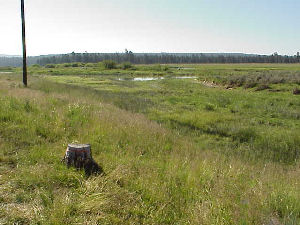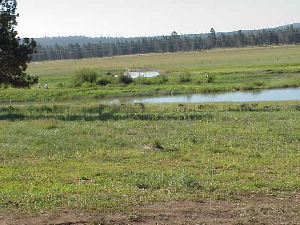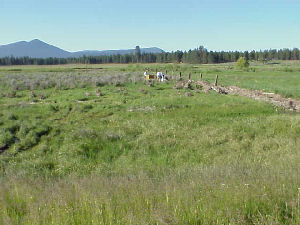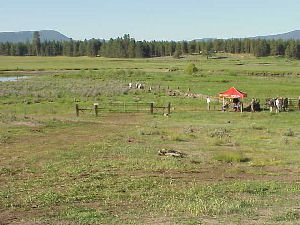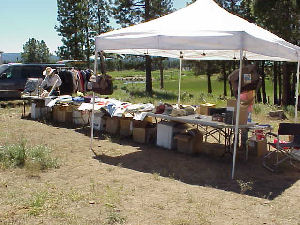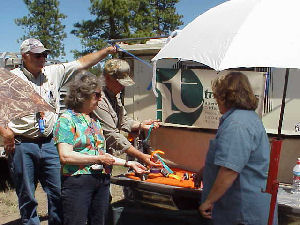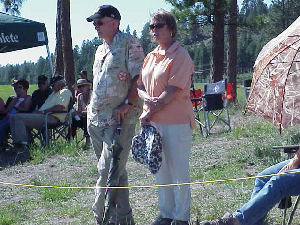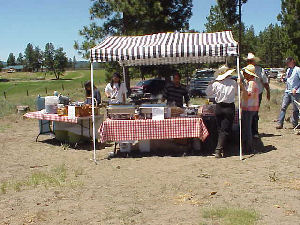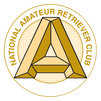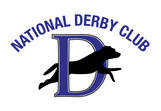Monday, June 19, 2006 |
Dawn arrived clear and quite cool. Temperatures were in the low 30's but the forecast was for near 80 and sunny. Overnight the stake had received some local press and a photo of Gordon Powers was posted in a story done by a local paper. Gordon is 90, has a competitive dog and is working on the Stewards committee at this event!
The drive back to the Rockin B Ranch was stunning. The warm water of lakes and streams along the way reacted to the cold temperature and produced cloud like steam. In some places it nearly obliterated the road and one had an ethereal feeling upon punching though it to the clear air beyond. Upon arrival at the ranch the water area was still enveloped in fog and it was difficult to see the gun stations. A rising sun quickly burned off the fog and buy 7:30 test dogs tried the series.
The drive back to the Rockin B Ranch was stunning. The warm water of lakes and streams along the way reacted to the cold temperature and produced cloud like steam. In some places it nearly obliterated the road and one had an ethereal feeling upon punching though it to the clear air beyond. Upon arrival at the ranch the water area was still enveloped in fog and it was difficult to see the gun stations. A rising sun quickly burned off the fog and buy 7:30 test dogs tried the series.
Test three was a water triple with two retired guns. The line faced a flowing stream (left to right) with a long, relatively narrow, grassy peninsula parallel to and beyond it. In the center was a stand of fairly thick bushes .A set of guns was stationed on each side of the brush about 100 yards apart and nearly equal distance from the line. Just to the right of the line, about 40 yards away, in a large patch of sagebrush a trio of live guns rested. From the line to the water a bare dirt swale divided a fence line on the left from the raised sagebrush area on the right. It probably appeared as a road to the dogs.
The throwing order was: Left gun, a dead duck flat to the left. It landed near the shore about 174 yards from line. The middle gun then threw a dead rooster flat to the right. It landed on the grassy island about 150 yards out. Lastly, the short right guns shot a flying duck angled back to the left. It fell in the sagebrush about 80 yards away. As the dog retrieved it, the island guns retired to well camouflaged blinds in the bushes.
At 7:35 the first test dog appeared on line . He handled on the middle bird. The second one had good work.
Contestants and gallery were allowed to view the line prior to the appearance of the first running dog, #96. He arrived at 8:06 a.m. and produced nearly flawless work.
The close flyer was somewhat difficult to locate in the sagebrush and excited the dogs - possibly to the point of blurring memory's of the other two. After the first running dog the pitfalls became evident. Apparently the middle pheasant had little scent and early handlers sent for it second. The dirt "road" perpendicular to the water funneled dogs to a line between the gun stations. Beyond it, the current could also influence the dogs line. If they passed by the middle pheasant, perhaps looking for another duck,they drove deep behind the bushes. Unfortunately, then they could arrive, unseen, at the left mark and recover it instead. When resent for the middle bird, some tried to return to the left one, believing they had picked it up. Several handled and one switched.
As the test progressed, some handlers tried for the left bird before the middle one. That met with mixed success. After 12 dogs had run it appeared that this was a demanding set of marks.About one third had handled, switched or picked up. Hopefully, the work would improve as the day wore on. In all fairness,however, a few had very good work, too. Nervous handlers watched the impending train wreck from high on the hill, re-thinking their strategy.
By mid morning the wind had switched and dogs could scent the birds easier.. For the rest of the afternoon, however, performance quality would run in streaks. There would be several handles or a pick up and then a number of fine jobs. Occasionally dogs would get into the water and channel along the near side of the bank. There they could travel, mostly unseen, until they exited far out of the area. Other would drive either over or past the island and land on the far shore or go undetected behind the island traveling nearly to the pasture several hundred yards beyond. Some handlers could recover, but many could not.
Long hunts, handles and pick-ups slowed the series and at 5:20 an announcement was made that the test would be suspended after dog 85 ran. It would resume Tuesday with a single test dog at 7:30 a.m.There were 25 dogs left to run. At about 7;35 another announcement was made that the test would be suspended after dog 80 ran instead. (Dog 80 received a no bird a no bird and will run on Tuesday.) The test was suspended at 8 p.m. There will be no partial call backs this evening and sixteen dogs are left to run in the morning . After, the fourth series, a water blind will be held in the same area.
Of the 76 dogs that have run, 21 handled and/or picked up - nearly 30% of the field.
The throwing order was: Left gun, a dead duck flat to the left. It landed near the shore about 174 yards from line. The middle gun then threw a dead rooster flat to the right. It landed on the grassy island about 150 yards out. Lastly, the short right guns shot a flying duck angled back to the left. It fell in the sagebrush about 80 yards away. As the dog retrieved it, the island guns retired to well camouflaged blinds in the bushes.
At 7:35 the first test dog appeared on line . He handled on the middle bird. The second one had good work.
Contestants and gallery were allowed to view the line prior to the appearance of the first running dog, #96. He arrived at 8:06 a.m. and produced nearly flawless work.
The close flyer was somewhat difficult to locate in the sagebrush and excited the dogs - possibly to the point of blurring memory's of the other two. After the first running dog the pitfalls became evident. Apparently the middle pheasant had little scent and early handlers sent for it second. The dirt "road" perpendicular to the water funneled dogs to a line between the gun stations. Beyond it, the current could also influence the dogs line. If they passed by the middle pheasant, perhaps looking for another duck,they drove deep behind the bushes. Unfortunately, then they could arrive, unseen, at the left mark and recover it instead. When resent for the middle bird, some tried to return to the left one, believing they had picked it up. Several handled and one switched.
As the test progressed, some handlers tried for the left bird before the middle one. That met with mixed success. After 12 dogs had run it appeared that this was a demanding set of marks.About one third had handled, switched or picked up. Hopefully, the work would improve as the day wore on. In all fairness,however, a few had very good work, too. Nervous handlers watched the impending train wreck from high on the hill, re-thinking their strategy.
By mid morning the wind had switched and dogs could scent the birds easier.. For the rest of the afternoon, however, performance quality would run in streaks. There would be several handles or a pick up and then a number of fine jobs. Occasionally dogs would get into the water and channel along the near side of the bank. There they could travel, mostly unseen, until they exited far out of the area. Other would drive either over or past the island and land on the far shore or go undetected behind the island traveling nearly to the pasture several hundred yards beyond. Some handlers could recover, but many could not.
Long hunts, handles and pick-ups slowed the series and at 5:20 an announcement was made that the test would be suspended after dog 85 ran. It would resume Tuesday with a single test dog at 7:30 a.m.There were 25 dogs left to run. At about 7;35 another announcement was made that the test would be suspended after dog 80 ran instead. (Dog 80 received a no bird a no bird and will run on Tuesday.) The test was suspended at 8 p.m. There will be no partial call backs this evening and sixteen dogs are left to run in the morning . After, the fourth series, a water blind will be held in the same area.
Of the 76 dogs that have run, 21 handled and/or picked up - nearly 30% of the field.


